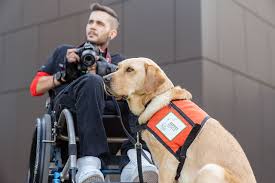The Importance of a Dog Leash
A dog leash is an essential tool for every dog owner. Not only does it provide control and safety during walks, but it also plays a crucial role in training and bonding with your furry friend.
Control and Safety
Using a leash allows you to guide your dog and prevent them from running off or getting into potentially dangerous situations. It helps you maintain control over your pet in public spaces, around other animals, and near busy roads. A leash also ensures that your dog stays close to you, reducing the risk of accidents or confrontations with other dogs or people.
Training Aid
A leash is a valuable tool for training your dog. By using a leash during obedience training sessions, you can teach your dog to walk politely on a leash, respond to commands, and learn proper behavior in various situations. Consistent leash training can help improve your dog’s behavior both on walks and at home.
Bonding with Your Dog
Walking your dog on a leash provides an opportunity for quality bonding time. It allows you to explore the outdoors together, engage in physical activity, and strengthen the connection between you and your pet. Regular walks on a leash help build trust and communication between you and your dog, leading to a deeper bond.
Choosing the Right Leash
When selecting a dog leash, consider factors such as length, material, and clip type. Choose a sturdy leash that matches your dog’s size and strength. Reflective or brightly colored leashes can enhance visibility during low-light conditions for added safety.
Remember that using a leash responsibly is not only beneficial for your dog but also promotes harmony in shared spaces with other pet owners and non-pet owners alike.
7 Essential Tips for Choosing and Using Your Dog’s Leash
- Always use a sturdy leash made of high-quality material.
- Choose an appropriate length for the leash based on your dog’s size and behavior.
- Ensure the leash is securely attached to your dog’s collar or harness.
- Practice loose-leash walking to prevent pulling and encourage good behavior.
- Regularly check the leash for any signs of wear and tear, and replace if necessary.
- Avoid using retractable leashes in busy or crowded areas for better control over your dog.
- Properly store the leash when not in use to prevent tangling or damage.
Always use a sturdy leash made of high-quality material.
It is crucial to always use a sturdy leash made of high-quality material when walking your dog. A durable leash ensures that you have reliable control over your pet, especially in unpredictable situations. High-quality materials can withstand pulling and tugging, reducing the risk of breakage and potential harm to your dog. Investing in a well-made leash not only enhances safety but also provides peace of mind during walks, allowing you to focus on enjoying quality time with your canine companion.
Choose an appropriate length for the leash based on your dog’s size and behavior.
When selecting a dog leash, it is crucial to choose an appropriate length that suits your dog’s size and behavior. A shorter leash may provide more control over a larger or more energetic dog, while a longer leash can give a smaller or less active dog more freedom to explore. Understanding your dog’s behavior and tendencies will help you determine the ideal length that promotes both safety and comfort during walks.
Ensure the leash is securely attached to your dog’s collar or harness.
It is crucial to ensure that the leash is securely attached to your dog’s collar or harness before heading out for a walk. A properly fastened leash provides a reliable connection between you and your dog, preventing the risk of it coming loose unexpectedly. By double-checking the attachment, you can enjoy peace of mind knowing that your furry companion is safe and under your control during outdoor activities.
Practice loose-leash walking to prevent pulling and encourage good behavior.
To prevent pulling and promote good behavior, practicing loose-leash walking is essential for dog owners. By teaching your dog to walk calmly by your side without pulling on the leash, you can enhance the walking experience for both you and your furry companion. This training technique not only encourages proper leash manners but also strengthens the bond between you and your dog, fostering a positive and enjoyable walking routine. Consistent practice of loose-leash walking can lead to improved behavior and a more pleasant walking experience for both you and your canine friend.
Regularly check the leash for any signs of wear and tear, and replace if necessary.
It is important to regularly inspect your dog’s leash for any indications of wear and tear. Over time, constant use can lead to fraying, weakening, or damage to the leash material. By routinely checking the leash for signs of deterioration, you can ensure its reliability and safety during walks with your furry companion. If you notice any issues or concerns, it is advisable to replace the leash promptly to maintain control and prevent any potential accidents while out with your dog.
Avoid using retractable leashes in busy or crowded areas for better control over your dog.
It is advisable to avoid using retractable leashes in busy or crowded areas to ensure better control over your dog. Retractable leashes can make it challenging to quickly reel in your dog, especially in situations where you need immediate control, such as navigating through crowded streets or encountering other dogs. Opting for a standard fixed-length leash in such environments provides more stability and control, reducing the risk of accidents or unwanted interactions. By using a traditional leash in busy areas, you can effectively manage your dog’s movements and prioritize safety for both your pet and those around you.
Properly store the leash when not in use to prevent tangling or damage.
Properly storing your dog leash when not in use is essential to prevent tangling or damage. By hanging or coiling the leash neatly in a designated storage area, you can prolong its lifespan and ensure that it remains in good condition for your next walk. Avoid leaving the leash lying on the ground or exposed to harsh elements, as this can lead to wear and tear. Taking care of your leash when it’s not in use helps maintain its functionality and keeps it ready for whenever you need it.




